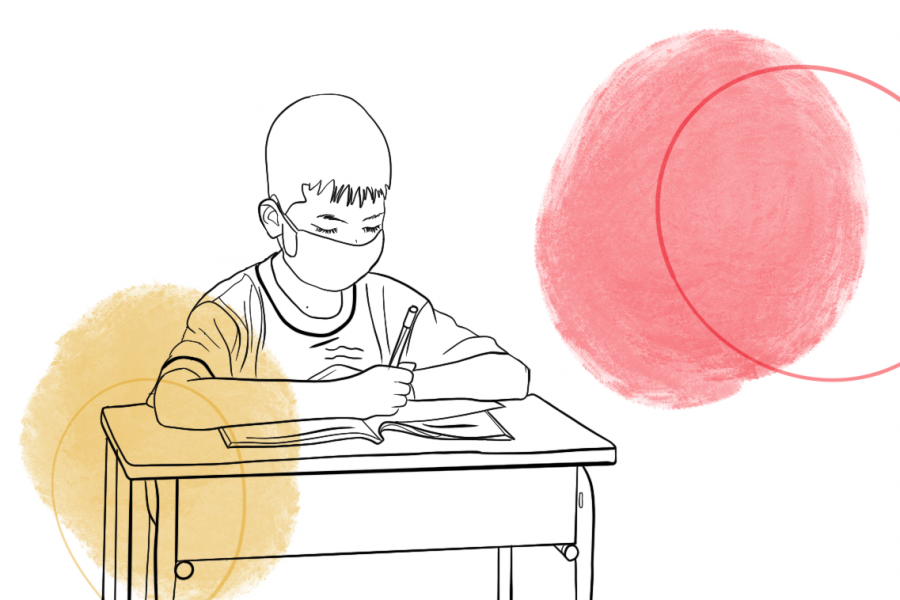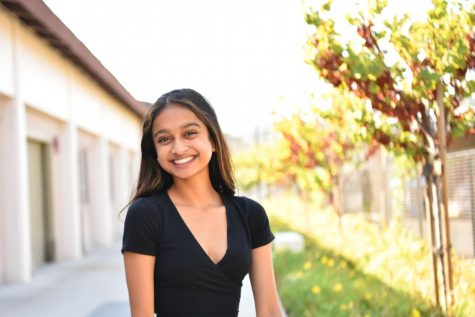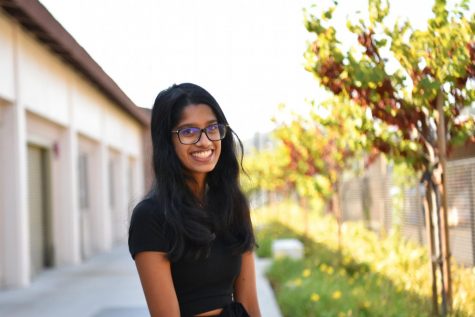“Parent bullies” and “teachers who cried wolf”
How disadvantaged students and financial incentives led to schools resuming in-person instruction
Investigating the interactions between teachers, unions, districts and communities that shaped the reopening of schools
March 19, 2021
Desks, once grouped together in friendly clusters, are now islands spaced six feet apart, dotting the classroom landscape. Hand sanitizer bottles and disinfecting wipes ornament the tables along the rooms’ perimeter while plastic screens partition the room into an uninviting grid. Colorful posters on the walls instruct students to wear masks over their mouths and noses and tape markers outside the classroom door offer neon reminders to remain socially distanced despite the hustle and bustle of passing periods.
This is the backdrop of schools across California after Gov. Gavin Newsom announced that schools that opened from transitional kindergarten to second grade would receive $2 billion in grants, as a part of a larger initiative to bring California’s six million schoolchildren — most of whom have been learning online since March of 2020 — back to classrooms. Newson has faced harsh criticism from Democrats and Republicans alike regarding his lack of action reopening schools and businesses — a frustration that has mounted a growing effort to recall the governor. California has lagged behind several other states in reopening its schools, in part because of the stalemate Newsom’s administration reached with teachers unions across the state.
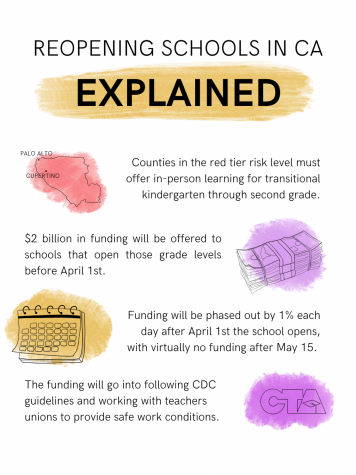
According to the Center for Public Justice, “Teachers’ unions exist to make sure that schools treat teachers justly. The largest function of a teachers’ union is to ensure that employees have the best possible work conditions.” There are two primary unions at any school in California — one that represents the faculty, generally a chapter of the California Teachers’ Association (CTA), and one that represents school support staff such as custodians and librarians, generally a chapter of the California School Employee Association (CSEA).
Although unions allow staff to have a collective voice and influence certain school-related decisions, “the district and Board of Ed have the right to make decisions without our agreement,” such as the decision of when to return to in-person learning, President of the Palo Alto Educators Association (PAEA) Teri Baldwin wrote in an email. The Palo Alto Unified School District (PAUSD) board decided that high school students would resume in-person learning on March 9, seven days after Santa Clara County exited the Purple Tier and entered the Red Tier of California’s Blueprint for a Safer Economy — a color-coded metric system designating the COVID-19 risk level of different counties. Vice President of the Palo Alto Educators Association (PAEA) David Cohen explains that he personally feels this decision was made too hastily and that schools could have reopened “a little bit later with a lot less stress.” Baldwin agrees, stating that although she would have appreciated if their “Board of Education would not bring more educators and students back in person until everyone is fully vaccinated,” she knew that “educators will do their best to try to keep themselves, their colleagues and their students as safe as possible.”
PAEA President Teri Baldwin asked the #PAUSD community and Board to bear in mind that some of our members are already working in person; risks are real, and concern about those risks not irrational.
— PaloAltoEducatorsAsc (@PaloAltoEduAsc) February 10, 2021
After eight months of remote learning, Kennedy Middle School eighth grade teacher and member of the Cupertino Education Association (CEA) Ami Byrne has settled into the routine of conducting classes over Zoom, saying that she has learned to teach effectively despite the unexpected circumstances. She explains that due to the upcoming switch to hybrid learning in Cupertino Union School District (CUSD) schools on April 5, each school has adopted a new set of rules and restrictions in order to follow safety guidelines, and it may be hard for teachers to make the adjustment to a hybrid model after finally learning to teach remotely.
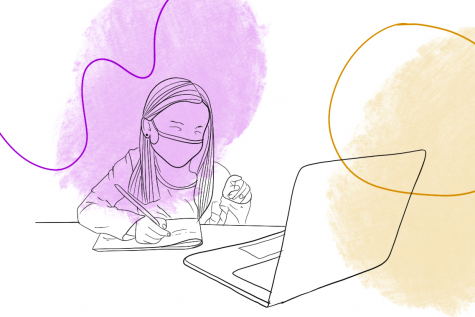
“It’s taken us so long to adjust to a system where I feel like I’m actually giving pretty good teaching and education,” Byrne said. “It’s taken a long time to get there, [so] why disrupt that for kids?”
In addition to the struggle of switching from remote to hybrid learning, many teachers are fearful of the health risks that in-person learning will bring. Palo Alto High School photography teacher Margo Wixsom explains that due to her several pre-existing health conditions as well as a disability, no longer being able to teach remotely means putting herself in danger every day she returns to school — something she believes is unnecessary and avoidable.
“Half a million people and then their families — why would you want to put more people in that situation?” Wixsom said in an email. “This is a very real and traumatic threat to us. Never in my life have I been afraid for my life going to work until this last year. It seems pretty simple how to resolve this — wait until everyone is vaccinated.”
Byrne postulates that many parents who advocate for schools reopening immediately believe that teachers are only thinking out of concern for themselves, and not considering the students who find remote learning an impossible task and require in-person instruction. She says that there is a gap in communication and understanding between the teachers and parents, recalling a board meeting where tensions soared to the point of name-calling.
“I missed the very beginning of the meeting, but apparently parents were called bullies […] so then every time a parent wanted to speak, [they] would say ‘If trying to do what’s best for my child makes me a bully, then that’s what I am,’” Byrne said. “Then we had parents get on and say ‘Teachers are crying wolf, teachers are delusional, teachers need to just go do their job.’”
Cohen, who also manages the PAEA Twitter account, explains that he has used social media to help bridge the communication gap between unions and communities. He tries to provide resources for teachers and community members alike on the account, but explains that tweets are not always effective, citing low levels of engagement with the posts. Along with the Twitter account, PAEA created a website to post updates on current work conditions, member concerns and information about vaccines.
3. While adults on staff are undergoing bi-weekly surveillance testing, there’s no surveillance testing for students. Add that fact to the combination of asymptomatic spread and new variant strains of COVID, and it’s hard not to be worried.
— PaloAltoEducatorsAsc (@PaloAltoEduAsc) February 28, 2021
While giving struggling students the opportunity to return to in-person instruction was a major motivating factor for schools to reopen in March, Byrne explains that many districts in California — including CUSD — were also influenced by another factor: money. Newsom’s $2 billion grant to schools across the state comes with a catch — starting April 1, the funding that schools receive for reopening is incrementally phased out 1% each day until May 15, when schools get virtually no money for reopening schools at all, according to The New York Times. Newsom’s administration included this measure in the bill to incentivize schools to reopen as quickly as possible, and as for many low income districts, opening without the additional money and resources from the government would be impossible.
Cohen explains that there are two types of public school districts in California: basic aid and revenue limit. Basic aid districts like PAUSD and FUHSD tend to be more wealthy as they receive a fixed amount of money from the state, while the rest of their funding — as much as 90% — comes from property taxes. Revenue limit districts, however, receive a majority of funding from the state. According to Byrne, that amount is in tandem with attendance which means that revenue limit districts like CUSD, “unlike other districts, have no money” and are in a “financial hole” due to declining enrollment.
A lack of sufficient funding lends itself to a number of obstacles, including an inability to implement safety measures that are in line with CDC guidelines. Not being able to abide by CDC guidelines, however, is not an issue restricted to revenue limit districts — for example, the CDC recommends increasing ventilation to reduce the “concentration of virus particles in the air” by opening classroom windows or doors, but MVHS doesn’t have any classrooms with windows that open. But even before enough safety precautions were implemented for the announcement of the hybrid model, certain teachers were volunteering to teach cohorts of students who faced special challenges due to remote learning in person, according to Assistant Principal Janice Chen. One such volunteer, Chemistry teacher Mia Onodera, explains that she performs lab experiments with six to seven English Language Development (ELD) students each Tuesday despite being “quite paranoid” for her health.
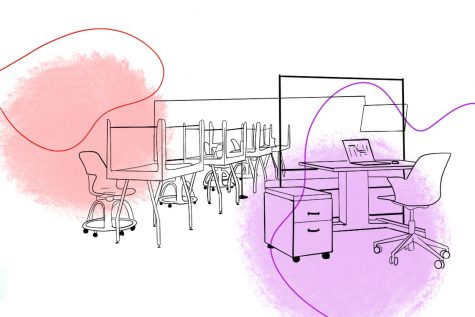
“I don’t feel chemistry is real without being able to do things in the classroom,” Onodera said in an email. “The main reason I chose to offer in-person labs was to make chemistry class like chemistry class. Both students in the room and at home indicated that they felt that the experience has enriched the class experience.”
Byrne is also a mother of three children, all of whom attend Cupertino public schools — she has a junior at Cupertino High School, an eighth grader at Kennedy Middle School and a fifth grader at Regnart Elementary School — and empathizes with parents, stating that she understands the frustration behind the lack of normalcy in the lives of her kids. She also understands the perspective of a teacher trapped behind a computer screen, stating that teaching virtually is “horrible” and that “there’s nothing [she] would love more than to have all [of her] students be in [her] classroom.”
But Byrne explains that she also understands that for many teachers and students, returning to school poses a risk to their lives that is crucial to consider. She urges parents and students to view the reopening of school through the lens of educators and administrators who are doing their best to ensure a safe environment for everyone.
“We want to do what’s best for kids, that’s why we’re educators,” Byrne said. “Everything I do in my classroom and the way I teach is all about, ‘How is this going to affect kids?’ and ‘Is this best for kids?’ [Regarding] going back to the classroom, for some kids, maybe that is what’s best. So I feel like we’ve sort of struck a balance, and that [we’re] doing the best that we can, given the parameters that we have.”



